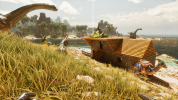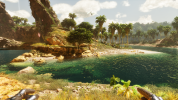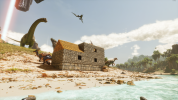Jusant is a perfectly fun game, especially if you happen to have Gamepass at the moment (just ending for me but I should be done with the game like, tonight).
It's an interesting showcase of UE5 in that it's not targeting super high end visuals, but the super clean art design lets you get a good look at the technical features. I put TSR on to see where it's at, and it's much improved over previous versions. Relatively low cost, aliasing increases while under heavy camera motion of course but that's all these upscaling features. Otherwise it's a very solid competitor with very little in the way of obvious movement breakup on primary geometry. Of course it falls down completely with dramatic shading changes, you can see the shadows glitch out as your character moves in anything but a straight line, and while they're cleaned up quickly it's still very obvious, a reminder that temporal upscaling has variable rate shading as it's obviously better but more development time cost partner out there.
It's also a great showcase of Lumen, and it's limitations. Going with software only Lumen is fine as the art style is diffuse only without much in the way of sharp features, so most of the time the resolution limitations aren't noticeable at all. The thing that is noticeable is the light bounce limitations, every cave is either pitch black very quickly (and the game is like half caves) or there's a lightsource in the cave which is very often. To get around these limitations the artists have put wide area lights faking more GI into cave exits all over the place, abusing the virtualized shadow maps until they have obvious overlap issues, but otherwise they're done pretty well and serve to brighten up otherwise pitch black caves. As this wouldn't work well in a non fixed time of day scenario though it seems an obvious limitation on Lumen in open world type games.
I'll see if I can get some screenshots tonight.



